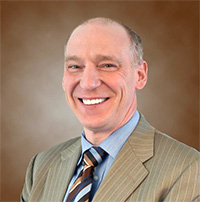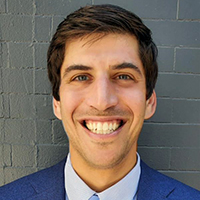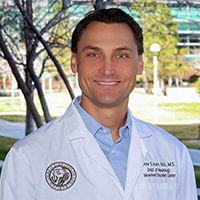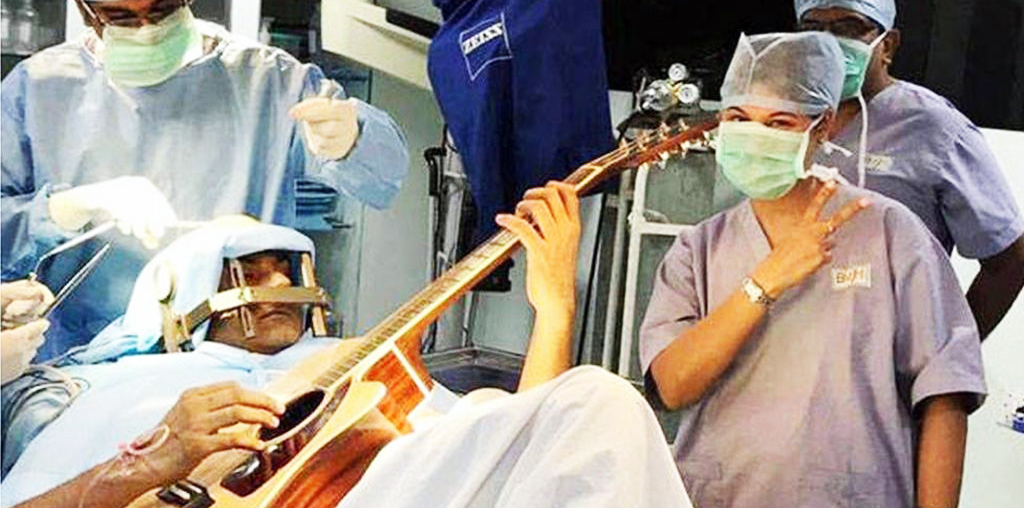Functional & Movement Disorder Neurosurgery Program of Excellence
Typically, functional and restorative neurosurgery involves minimally invasive procedures performed through small incisions or openings in the skull, often with the assistance of image guidance and intraoperative navigation systems. Functional and restorative neurosurgery uses cutting-edge technology to restore lost neurological function or prevent further functional declines.
 Historically,
neurosurgery has improved the environment of the nervous system to promote maximal spontaneous recovery of function. The population of patients whom we treat at present is a small portion of those who suffer from disabling neurological illnesses,
but with advanced techniques and ongoing research, this number is growing. Restorative neurosurgery is advancing the frontiers of our specialty, and providing the potential to restore lost function. Significant advancements in gene therapy,
the discovery and delivery of neurotrophic factors, and cell transplantation now require neurosurgeons to broaden the scope of our practice so that it includes the restoration of function in an enormous number of patients with acquired, degenerative
and idiopathic neurological diseases. In order to meet the present challenge, neurosurgeons must broaden our vision, our role, and our future educational goals.
Historically,
neurosurgery has improved the environment of the nervous system to promote maximal spontaneous recovery of function. The population of patients whom we treat at present is a small portion of those who suffer from disabling neurological illnesses,
but with advanced techniques and ongoing research, this number is growing. Restorative neurosurgery is advancing the frontiers of our specialty, and providing the potential to restore lost function. Significant advancements in gene therapy,
the discovery and delivery of neurotrophic factors, and cell transplantation now require neurosurgeons to broaden the scope of our practice so that it includes the restoration of function in an enormous number of patients with acquired, degenerative
and idiopathic neurological diseases. In order to meet the present challenge, neurosurgeons must broaden our vision, our role, and our future educational goals.
Functional Neurosurgery is a Multidisciplinary Specialty
It would not be possible to perform this type of surgery without the help of numerous specialists, including neurologists, radiologists, engineers, and more. Here are some of our partners:
Neurology
- Cornelia Drees – Epilepsy
- Drew Kern – Functional Movement Disorders
- Maureen Leehy – Movement Disorders
- Mark Spitz – Epilepsy
- Lauren Frey- Epilepsy
- Laura Strom- Functional Neurological Disorders
- Archena Shrestha- Epilepsy
Clinical Pharmacology
Curt Freed, MD, Division Head, Pharmacology Professor of Medicine
Neurosurgeons

Stephen Ojemann, MD |  Daniel Kramer, MD
Daniel Kramer, MDAssistant Professor |
Supporting Neurologist in Complex Movement Disorders
 Drew Kern, MD, MS Drew Kern, MD, MSAssociate Professor |
Modalities Offered
- Craniotomy for intractable epilepsy
- Intra-operative EEG monitoring
- Intracranial electrode grid placement
- Vagal nerve stimulation
- Deep brain stimulation (DBS) – movement disorder
- Neuro-transplantation
- Neuropace
Lesions treated
- Movement disorders secondary to Parkinson's, essential tremor, dystonia
- Intractable epilepsy
- Pain
About Deep Brain Stimulation
 Deep brain stimulation is an established treatment for people with movement disorders, such as essential tremor, Parkinson's disease and dystonia, and psychiatric conditions, such as obsessive-compulsive disorder. Deep brain stimulation (DBS) is an elective surgical procedure in which electrodes are implanted into certain brain areas. These electrodes, or leads, generate electrical impulses that control abnormal brain activity. The electrical impulses can also adjust for the chemical imbalances within the brain that cause various conditions. Stimulation of brain areas is controlled by a programmable generator that is placed under the skin in the upper chest.
Deep brain stimulation is an established treatment for people with movement disorders, such as essential tremor, Parkinson's disease and dystonia, and psychiatric conditions, such as obsessive-compulsive disorder. Deep brain stimulation (DBS) is an elective surgical procedure in which electrodes are implanted into certain brain areas. These electrodes, or leads, generate electrical impulses that control abnormal brain activity. The electrical impulses can also adjust for the chemical imbalances within the brain that cause various conditions. Stimulation of brain areas is controlled by a programmable generator that is placed under the skin in the upper chest.
For more information, please click on one of the links in the column to the left.
About Epilepsy Surgery
Different surgeries are available for different types of epilepsy . These include:
- Focal Resection
- Temporal Lobe Resection
- Extratemporal Resection (frontal , parietal, and occipital )
- Lesionectomy
- Multiple Subpial Transections
- Laser Interstitial Thermal Therapy
- Anatomical or Functional Hemispherectomy and Hemispherotomy
- Corpus Callosotomy
- Stereotactic Radiosurgery
- Neurostimulation Device Implantations , including
- Vagus Nerve Stimulation (VNS)
- Responsive Neurostimulation (RNS)
- Deep Brain Stimultaion (DBS)
For more information about epilepsy surgery, please click on one of the links in the column to the left.
To make an appointment
call 720.848.2080
call 720.848.2080
